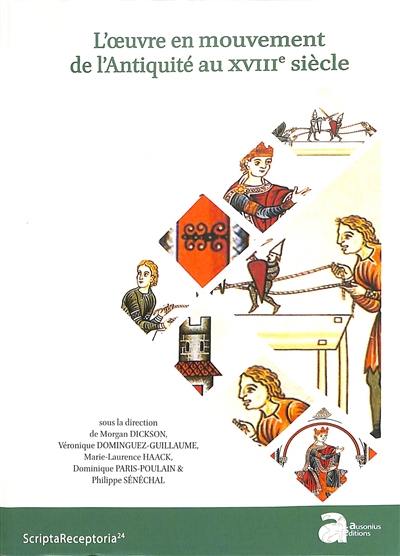
Collection(s) : Scripta receptoria
Paru le 09/12/2022 | Broché 391 pages
Public motivé
L'oeuvre en mouvement de l'Antiquité au XVIIIe siècle
Les 22 essais qui constituent le présent ouvrage analysent le mouvement dans un ensemble varié d'oeuvres littéraires, iconographiques et musicales, de l'Antiquité au XVIIIe siècle. Après un cadrage philosophique et historique de la notion au moyen du rythmos, compris comme temps, forme, ou mesure, la réflexion est déclinée en trois moments. « Figures du mouvement » s'intéresse aux formes du mouvement restituées par la tradition textuelle médiévale, inscrites dans les portails romans d'Aquitaine, les Annonciations flamandes et les extases baroques, ou gravées dans des objets du quotidien, vaisselle ou jetons. « Objets en mouvement » considère les oeuvres dans leur matérialité, et examine la circulation des parfums antiques et des objets votifs médiévaux, le mécanisme des « marionnettes sacrées » du Christ et de la machinerie théâtrale, ou le fonctionnement des processions, rituelles ou profanes, en Italie et dans l'espace franco-bourguignon. Enfin, avec « Mouvements du corps », entre iconographie étrusque, rondeaux latins et acrobates des chapiteaux romans, la gestualité est décrite et analysée dans la musique et dans la danse, réelle ou sculptée. Le mouvement apparaît ainsi comme l'une des modalités les plus accomplies de l'oeuvre d'art, qu'elle soit texte, tableau, sculpture, dispositif ou monument.
The twenty-two articles collected here explore the theme of movement in a variety of works, including the literary, visual and musical, spanning from the antique period through the eighteenth century. The collection opens with an examination of the notion of rythmos - understood as time, form or measure - from a historical and philosophical perspective. The study is then divided into three sections : the first, « Figures of Movement », focuses on forms of movement found in medieval texts, inscribed in the Romanesque portais of Aquitaine, depicted in Flemish images of the Annunciation and baroque visions of ecstasy, or engraved in objects related to daily life, such as crockery or commemorative coins. The second section, « Objects in Motion », addresses questions of materiality, examining diverse sources, from the circulation of perfumes in the antique period to a variety of medieval devotional objects, such as the mechanisms that powered the « holy marionettes » of Christ and related theatrical machinery, as well as the functioning of both sacred and profane processions in Italy and the Franco-Burgundian region. Finally, in the section entitled « Corporeal Movement », the gestures associated with music and dance are described and analysed in sources spanning from Etruscan iconography through Latin rondeaux to acrobats and dancers found on Romanesque capitals and in texts about holy women. Movement is thus shown to be one of the fullest means of expression in a work of art, whether in the form of text, image, sculpture, mechanism or monument.